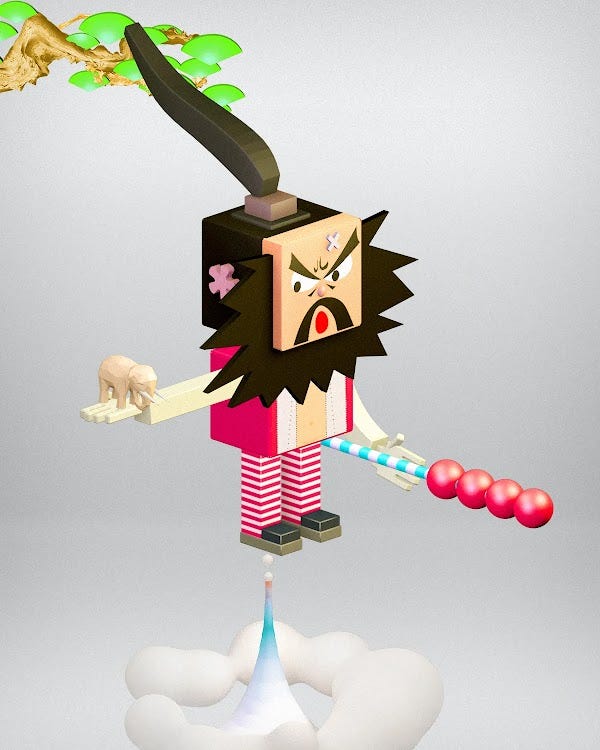If culture is capable of anything, then it is finding that which unites us all
Meme of the week
A while back, I formed a thesis that crypto is going through de-chinalization, a period where China’s anti-crypto regulation would force the miners and centralized exchanges to go on exile, while the rest go underground.
That did play out as we see almost all miners leaving China and chasing electricity all over the world ( one mining OG is even venturing into the Nordic countries)
Yet, little did I foresee the power of NFT.
All of a sudden, my crypto wechat was full of Punk fanboys, Ape guardians, and Loot revolutionaries
This weeks’ da bing aims to capture the current status of NFT in China, and why it’s here to stay.
Let’s distinguish the two types of NFTs in China:
Web2.0 NFTs are the JPEGs created by Chinese internet giants, such as Alibaba and Tencent. These JPEGs are:
relatively cheap
have no crypto element ( exchanged all in RMB and lives on a centralized ledger)
not tradable on secondary market
have distinct Chinese cultural elements (e.g. slangs, internet phenomena)
Web3.0 NFT are similar to the crypto NFT most people familiar with. There are, however, some differences. Chinese Web3.0 NFTs:
contain Chinese cultural element ( e.g. rivermen, and kungfu hero). Rivermen, especially, is derived from the longest painting in China. The painting is a household name and considered a national treasure
multichained, as many of them are launched on BSC
gamified: pioneered by Pop Mart’s Blind Box, many NFTs are not selling JPEGs but selling the “being-surprised” experiences
What are some of the biggest NFT Communities in China?
Club721 is the newest NFT club on the block, Club 721 is a community of NFT players who share the latest news, analysis and drops on NFT. From the original 7 people, the community has quickly expanded to more than 7000 community members.
Its success is inevitable in hindsight given the stage of NFT cycle we are in and its wealth creation effect. Everyone is rushing to mint the latest drop and making 10x exit.
Club721 came at the right time when there’s a great information fragmentation and asymmetry for Chinese audience to ape in the latest drop.
It feels like a bit like the early DeFi summer days where communities are formed around thought leaders who aggregate global information.
Going forward, Club721 aims to evolve into a gated NFT community similar to FWB or PleasrDAO, meaning that only members who hold community token/NFTs have the right to participate.
MAODAO is undisputedly the biggest NFT contributors, advocates and thought leaders in the space. Its RPC series and sheer dedication in the play-to-earn space distinguishes MAODAO from other JPEG-speculators.
Compared to many NFT studio that drops JPEGS and leave, MAODAO continues to build gaming and financial instruments based on its NFT. Metaverse is its end-game.
Lastly, what impressed me the most about MAODAO is how active it is in promoting Chinese culture through NFTs ( such as this Mooncake drop I received).
Again, MAODAO isn’t here to build your next rare items, but build a universe that people from various culture can relate to.
People’s Punk is an NFT community launched by YFII community, a fork of YFI.
The YFII community members purchase Punk173 and fractionalize it by launching a community token $DDDD. The token mooned right after fractionalization but the interesting phenomena is that only a handful of people sold their portion of the punk for fear of alienation by the group
After the Punk wave, The People’s Punk community also launched PLOOT, a copy of LOOT.
One of $DDDD’s main helm, Cao Yin, is one of China’s biggest NFT influencers. He has an acute sense of following the latest NFT trend and translate it to the wider Chinese audience.
Cao is also the core member of Cryptoart Panda, a community dedicated to Chinese artists and creators.
DDDD which means ( 带带弟弟 = let your little brother tag along = which means share alpha please)
TR Lab is, perhaps, your distant wealthy cousin.
It is a NFT studio that curates work from known artists. Their first project is from Cai Guoqiang, whose art work has sold for millions of dollars in real world.
The studio is still relatively new but backed by both Chinese and international capital such as dragonfly capital, a large crypto fund. We have yet to see more work from TR Lab, but this route of bringing established artists to the platform is a different play compared to the first three communities.
What’s next?
The web2.0 NFT will continue to evolve in a compliant way. The Chinese internet giants will build its own NFTs not on Ethereum but Ant Chain. Their NFTs will be advertised by local celebrities, and gain wider adoption.
More importantly, Chinese gaming giants will rapidly adopt NFTs to their existing gaming empires, and building a metaverse, perhaps bigger than the one that Facebook promised.
However,
Just like the internet, China’s metaverse will be one sanctioned and gated by the Great Wall.
The web3.0 NFT will be a tricky business. It’s closely tied to the crypto ecosystems and touches coins that would make the government a little anxious. At the moment, there’s no clear regulation against NFTs, perhaps due to its nascency. However, since people need crypto to purchase NFTs, if the government continues to crack down crypto onramp, web3.0 NFTs will face its barriers.
Perhaps a more concerning factor in China’s NFT landscape isn’t consumers’ participation but artists’ participation.
There are many reasons behind it and cultural barrier is perhaps the biggest one.
After all, NFT is a cultural business propelled largely by tastes, especially those of the influencers. We need more community such as Cryptoart Panda to cultivate and nurture domestic artists and creators. Without them, China will only remain as the consumer of this revolution.







